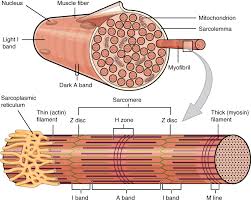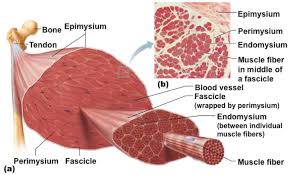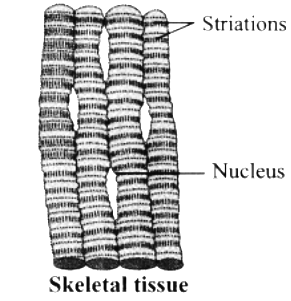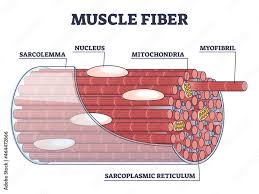muscles
INTRODUCTION
Muscles is a specialized tissue originating from from the mesoderm germ layer. The muscular tissue is made up of specialized cells called myocytes. These cells are bound together by a connective tissue and form muscular tissue. It brings about different types of movements in internal and external body parts. A human body is made up of 639 muscles which have unique properties like contractility, excitability, elasticity and extensibility. They make about 40-50 percent of body weight in an adult human.
The myocytes have the ability to contract. They can shorten by 1/3rd to 1/2nd of their length due to contraction and then return to its original length, so the property of shortening and then returning to relaxed to state of the muscle fibre is called elasticity. A stimulus such as nerve impulse, mechanical, thermal or chemical stimulus is required for excitation of the muscles which then causes muscles to contract. The stimulus received at one end of the muscle spreads almost immediately to other parts as well as to neighboring myocytes.
Structure of Muscle
A muscle is covered by a sheath of connective tissue called Inside the epimysium, a muscle has many muscle fibres arranged in a bundle called fascicule (singular-fasciculus or fascicle). Each fasciculus is surrounded by a sheath of connective tissue called perimysium. The muscle fibres are parallel to each other in the fasciculus and each muscle fibre is surrounded by a connective tissue called endomysium. All the muscle bundles are further bound together by a common collagenous sheath of connective tissue called fascia.
Tendons:- The two ends of the muscles are attached to the bone with the help of an inelastic connective tissue called tendon. One end of the muscle is attached to fixed or less moveble bone and the other end is attached to the more movable bone.
Types of Muscles
Muscles can be classified based on various criteria namely location, appearance, nature of regulation of their activities. Based on location, the muscles can be of following types.
(i) Skeletal muscle
These muscles are attached to the skeletal component of the body and are primary involved in the locomotory actions and changes of the body posture. When observed under a microscope, alternate light and dark bands are observed on the muscle fibres. Due to the striated appearance of the muscle fibres, these muscles are called striated or striped muscles. These muscles are voluntary as they are under the control of animals will or conscious. For example, muscles of hindlimbs, forelimbs, body wall, tongue, pharynx and beginning of oesophagus, etc
(ii) Visceral or non-striated:- The cells these muscles are elongated, spindle-shaped, broad from the middle and have tapering ends. These muscles do not have alternate light or dark bands on their muscle fibres and hence give a smooth appearance when observed under a microscope. Their fibres are not organized into parallel arrays.
These muscles lines the hollow organs and are involuntary. e.g., posterior region of oesophagus, stomach, intestine, lungs, urinary bladder, urinogenital track. The transportation of food through the digestive track and gametes through the genital track occurs due to the contraction of smooth muscles.
(iii) Cardiac muscle:- Cardiac means heart, hence muscles of the heart are called cardiac muscle. The cells of cardiac muscle assemble in a
branching pattern. These are striated in nature i.e.alternate light and dark bands could be observed on the muscle fibre when kept under the microscope. These are involuntary in nature as they generate their own impulse or excitation and hence allow heart to continue its pumping activity of rhythmic contraction and relaxation.
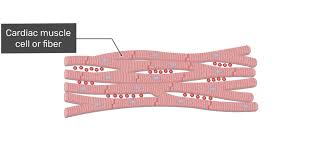
Differences between skeletal, Visceral and Cardiac muscle
S. No | Skeletal | Visceral | cardiac |
01 | These are cylindrical. | These are spindle-shaped | Muscle fibres are cylindrical |
02 | Their ends are blunt | Their ends are tapering | Their ends are blunt |
03 | Fibres are unbranched. | Fibres are unbranched | Fibres are branched |
04 | Fibres occur in bundles. | They occur singly, in sheets and small bundles. | They form three-dimensional network. |
05 | Blood supply is in abundance | Blood supply is poor | They are rich in blood supply |
06 | Voluntary in nature | Involuntary in nature | Involuntary in nature |
07 | They are innervated by branches from cranial and spinal nerves. | They are innervated by autonomic nervous system. | They are innervated by autonomic nervous system. |
08 | Intercalated discs are absent | Intercalated discs are absent | Intercalated discs are present. |
09 | These striated muscle fibres are multinucleate/syncytial. | Non-striated muscle fibres are uninucleated. | Cardiac muscle fibres are uninucleated. |
10 | Mitochondria are moderately abundant. | Mitochondria are fewer | Mitochondria are abundant. |
11 | Myoglobin is abundant | Myoglobin is poor | Myoglobin is abundant |
S. No | Skeletal | Visceral | cardiac |
12 | Striations are conspicuous | Striations are absent | Striations are present but faint. |
13 | They contract quickly | They contract slowly | They show rhythmic contractions. |
14 | They easily get fatigued. | They do not fatigue. | They do not fatigue. |
